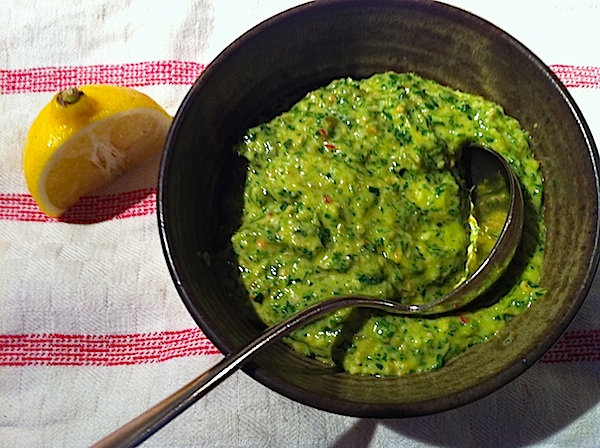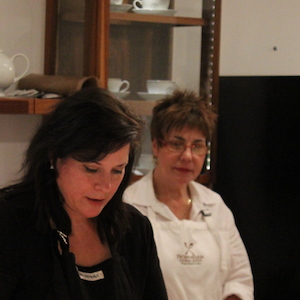Salsa verde literally means ‘green sauce’, and it refers classically to the herb and garlic accompaniment to boiled meats (bollito misto) from the North of Italy. While it’s a relatively rare day in our kitchen that sees a bunch of meats boiling away in water on the stove, we grill things all summer long and into the fall. Salsa verde is a lazy and delicious way to add flavour to simply barbecued cuts like pork or lamb chops, chicken breasts or even plainly seasoned sausages – it’s remarkably versatile.
The benchmark version from Lombardy includes parsley, basil and mint, olive oil, garlic, anchovy, vinegar, capers and sometimes a little mustard to bind the emulsion. Salsa verde is really part of supra-national family of green, herb and garlic based sauces including gremolata from Lombardy’s neighbour Piedmont, persillade (France), chimichurri (Argentina), and grune sosse (Germany). (Mint sauce might even qualify as distant English cousin.)
I believe the ubiquity of salsa verde like sauces across Western cuisines gives me license to fool around with its composition. I have long abandoned the recipe from with I first made it (it was from one of the River Café cookbooks, probably the first (Blue) one) and would have had instructions to use a mortar and pestle. Hand chopping and grinding is good fun, and may even produce subtler flavours (Donna Dooher swears stainless steel should never touch a clove of garlic), but I am happy to mash everything up in my food processor. The important thing is to make a lot, since it will keep for a few days in the fridge and is delicious re-purposed onto boiled potatoes the next night.
Five Minute Salsa Verde
Extra virgin olive oil
Red wine vinegar or lemon juice
1 or 2 cloves of fresh garlic
1 or 2 fillets of canned anchovy (optional)
Green herbs (parsley, basil, mint, chives, rocket, marjoram, etc.) in whatever combination you like
Dijon mustard
Caper buds
Salt and Pepper
Start by whizzing up one or two cloves of garlic and an anchovy filet or two in a little bit of olive oil and red wine vinegar (or lemon juice) in the food processor until you have a paste (chilies, fresh or dried, could be added at this point too). Then, stuff as many green herbs loosely into the chamber of the machine. Parsley, basil and mint are the classics, but chives, rocket, marjoram, thyme are great additions. Any combination or permutation of green herbs will do – whatever is in the garden. Add a dollop of Dijon mustard and start whizzing it up, while adding a stream of olive oil into the mixture until it is loose but firm. Once the herbs are sufficiently chopped to the point of not being sure what’s what, add a tablespoon or so of pickled caper buds (not the salted ones, the cheap pickled ones) and give the machine a few more whizzes so the capers are chopped-up, but not puréed. Move everything into serving bowl, season with salt and pepper to taste, and add a drizzle of olive oil to break and loosen the sauce a little, if it seems to stiff.
 Malcolm Jolley is a founding editor of Good Food Revolution and Executive Director of Good Food Media, the not-for-profit corporation which publishes it. Follow him at twitter.com/malcolmjolley
Malcolm Jolley is a founding editor of Good Food Revolution and Executive Director of Good Food Media, the not-for-profit corporation which publishes it. Follow him at twitter.com/malcolmjolley








